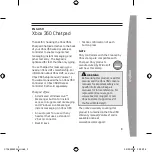
FCM 300 Series
MG.03.B6.2G - VLT is a registered Danfoss trademark
Maximum permissible external axial and radial loads in N (1N
= 0.225 lbf) angular contact bearings
Horizontal shaft
Vertical shaft
Load towards Load away
Shaft up
Shaft down
Frame
motor
from motor
load
load
load
load
size
Poles
Up
Down
Up
Down
Max. radial
2
80
2
1375
2205
2405
1225
1470
2160
3190
4
1865
2745
2845
1715
1960
2600
3925
90
2
2060
3190
2990
1470
1865
2600
4120
4
2700
3825
3580
2010
2355
3140
4515
100
2
4265
4265
4660
4660
4070
4070
6035
4
5050
5050
5590
5590
4805
4805
6965
112
2
4265
4265
4660
4660
4070
4070
6035
4
5050
5050
5590
5590
4805
4805
6965
132S
2
5295
7015
7850
4760
6080
6525
8925
4
6325
8045
9125
5690
7360
7405
9860
132M
4
6280
8045
9270
5545
7505
7310
10200
1
All figures are based on Lna bearing life of 20,000 hours.
Lna = adjusted L10 life rating taking account of:-Reliability -Material improvements -Lubrication conditions
2
Max. permissible radial load at end of shaft (horizontal mounting).
Installation
■
Foot Mounting Bolt Torques
Face/Flange, feet and lid should be secured with the
bolt sizes and torque's detailed in the table below.
Foot mounting bolt torques
FCM Type Frame size Bolt diameter Torque
Nm.
305-307
80
M8 (taptite)
24-25
311-315
90
M8 (taptite)
24-25
322-330
100
M8 (taptite)
32-35
340
112
M8 (taptite)
32-35
355-375
132
M8 (taptite)
32-35
Face/Flange bolt torques
FCM Type Frame size Bolt diameter Torque
Nm
305-307
80
M5
5
311-315
90
M5
5
322-330
100
M6 (taptite)
8-10
340
112
M6 (taptite)
8-10
355-375
132
M6 (taptite)
8-10
LID screws torque: 2.2 - 2.4 Nm, Plastic plug (cable entrance) torque: 2.0 Nm
1 Nm = 1.196 lb-ft
■
■
■
■
■
Maintenance
Routine cleaning of the FCM 300
Routine cleaning of the FCM 300
Routine cleaning of the FCM 300
Routine cleaning of the FCM 300
Routine cleaning of the FCM 300
Remove the fan cover and ensure that all air inlet
holes are completely clear. Clean any dirt and
obstructions from behind the fan and along the ribs of
the frame, and between the motor and inverter.
Periodic maintenance of motor
Periodic maintenance of motor
Periodic maintenance of motor
Periodic maintenance of motor
Periodic maintenance of motor.....
a) Remove the inverter, the fan cover and the
fan which is keyed to the shaft extension.
Loosen and remove bearing cover screws and
endshield bolts/studs.The endshields should then
be eased off their spigots.
(b) The rotor can now be carefully withdrawn from
the stator, taking care not to damage the stator
bore and both stator and rotor windings.
(c) Having dismantled the motor, maintenance can
be carried out to remove all dirt. For this
purpose, the use of an air line supplying dry
compressed air under comparatively low
pressure is best, as a high velocity air-stream
can force dirt into the spaces between the
windings and insulation, etc. Grease-removing
solvents can cause damage to impregnating
varnish or insulation
(d) The FCM 300 should be re-assembled in the
reverse order from dismantling, remembering to
ease endshields onto bearings and spigots.
DO NOT USE FORCE.
(e) Before starting, check that the rotor spins
freely. Ensure that the electrical connections are
correct.
(f) Refit any pulley, coupling, sprocket etc. which
has been removed, being particularly careful to
ensure correct alignment with the driven part,
as misalignment will lead to ultimate bearing
trouble and shaft breakage.
(g) When replacing screws and bolts, care should
be taken to use only those with the grade
recommended by
the manufacturer. These must also be of
identical thread form and screw/bolt length
(see the table above).
6-3
















































